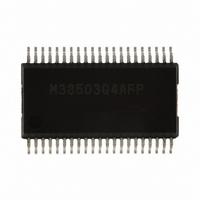M38503G4AFP#U1 Renesas Electronics America, M38503G4AFP#U1 Datasheet - Page 54

M38503G4AFP#U1
Manufacturer Part Number
M38503G4AFP#U1
Description
IC 740/3850 MCU QZ-ROM 42SSOP
Manufacturer
Renesas Electronics America
Series
740/38000r
Datasheet
1.M38507F8AFPU1.pdf
(61 pages)
Specifications of M38503G4AFP#U1
Core Processor
740
Core Size
8-Bit
Speed
12.5MHz
Connectivity
SIO, UART/USART
Peripherals
PWM, WDT
Number Of I /o
32
Program Memory Size
16KB (16K x 8)
Program Memory Type
QzROM
Ram Size
512 x 8
Voltage - Supply (vcc/vdd)
1.8 V ~ 5.5 V
Data Converters
A/D 9x10b
Oscillator Type
Internal
Operating Temperature
-20°C ~ 85°C
Package / Case
42-SSOP
Lead Free Status / RoHS Status
Lead free / RoHS Compliant
Eeprom Size
-
Available stocks
Company
Part Number
Manufacturer
Quantity
Price
3850 Group (Spec.A QzROM version)
Rev.2.13
REJ03B0125-0213
NOTES ON PERIPHERAL FUNCTIONS
Notes on Input and Output Ports
1. Notes in standby state
In standby state
“undefined”, especially for I/O ports of the N-channel open-
drain. When setting the N-channel open-drain port as an output,
do not make input levels of an I/O port “undefined”, too.
Pull-up (connect the port to V
to V
When determining a resistance value, note the following points:
• External circuit
• Variation of output levels during the ordinary operation
<Reason>
When setting as an input port with its direction register, the
transistor becomes the OFF state, which causes the ports to be
the high-impedance state.
Accordingly, the potential which is input to the input buffer in a
microcomputer is unstable in the state that input levels of an I/O
port are “undefined”. This may cause power source current.
In I/O ports of N-channel open-drain, when the contents of the
port latch are “1”, even if it is set as an output port with its
direction register, it becomes the same phenomenon as the case
of an input port.
NOTES:
2. Modifying output data with bit managing instruction
When the port latch of an I/O port is modified with the bit
managing instruction
changed.
<Reason>
The bit managing instructions are read-modify-write form
instructions for reading and writing data by a byte unit.
Accordingly, when these instructions are executed on a bit of the
port latch of an I/O port, the following is executed to all bits of
the port latch.
• As for bit which is set for input port:
• As for bit which is set for output port:
Note the following:
• Even when a port which is set as an output port is changed for
• As for a bit of which is set for an input port, its value may be
NOTES:
The pin state is read in the CPU, and is written to this bit after
bit managing.
The bit value is read in the CPU, and is written to this bit after
bit managing.
an input port, its port latch holds the output data.
changed even when not specified with a bit managing
instruction in case where the pin state differs from its port
latch contents.
4. Standby state:
5. Bit managing instructions: SEB and CLB instructions
SS
) these ports through a resistor.
Apr 17, 2009
*1
, do not make input levels of an I/O port
*2
stop mode by executing STP instruction
wait mode by executing WIT instruction
, the value of the unspecified bit may be
CC
) or pull-down (connect the port
Page 52 of 56
Termination of Unused Pins
1. Terminate unused pins
(1) I/O ports:
• Set the I/O ports for the input mode and connect them to V
• When opening them in the output mode, the input mode of the
• Since the direction register setup may be changed because of a
(2) The AV
• When not using the A/D converter, handle a power source pin
2. Termination remarks
(1) Input ports and I/O ports:
Do not open in the input mode.
<Reason>
• The power source current may increase depending on the first-
• An effect due to noise may be easily produced as compared
(2) I/O ports:
When setting for the input mode, do not connect to V
directly.
<Reason>
If the direction register setup changes for the output mode
because of a program runaway or noise, a short circuit may occur
between a port and V
(3) I/O ports:
When setting for the input mode, do not connect multiple ports in
a lump to V
<Reason>
If the direction register setup changes for the output mode
because of a program runaway or noise, a short circuit may occur
between ports.
• At the termination of unused pins, perform wiring at the
or V
which can select a internal pull-up resistor, the internal pull-up
resistor can be used.
Set the I/O ports for the output mode and open them at “L” or
“H”.
initial status remains until the mode of the ports is switched
over to the output mode by the program after reset. Thus, the
potential at these pins is undefined and the power source
current may increase in the input mode. With regard to an
effects on the system, thoroughly perform system evaluation
on the user side.
program runaway or noise, set direction registers by program
periodically to increase the reliability of program.
for the A/D converter, AV
AV
stage circuit.
with proper termination (1) in 1 shown on the above.
s h o r t e s t p o s s i b l e d i s t a n c e ( 2 0 m m o r l e s s ) f r o m
microcomputer pins.
SS
SS
: Connect to the V
through each resistor of 1 kΩ to 10 kΩ. In the port
CC
SS
or V
pin when not using the A/D converter:
SS
CC
through a resistor.
(or V
SS
SS
pin.
SS
pin as follows:
).
CC
or V
CC
SS

























